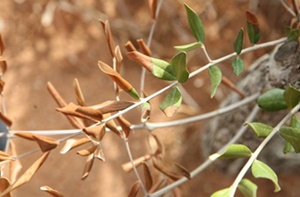Enquête préliminaire sur la présence de Xylella fastidiosa sur l'olivier, les agrumes et la vigne au Maroc
Résumé
Xylella fastidiosa, bactérie gram-négative, confinée au xylème, très polyphage, provoque diverses maladies sur plus de 300 plantes hôtes. Compte tenu de la récente détection confirmée de X. fastidiosa dans l'Union Européenne, cette bactérie est en train de devenir une menace sérieuse pour le secteur agricole marocain. Une enquête a été menée durant Mai-Septembre 2015 sur la présence de X. fastidiosa dans plusieurs plantations de l'olivier, des agrumes et de la vigne à travers le pays. Des symptômes sévères qui pourraient être associés à la bactérie ont été relevés. Un total de 900 échantillons de différentes cultures à partir de différentes régions ont été collectés au hasard: 220 oliviers (cv. Picholine Marocaine) de deux régions, 410 arbres d'agrumes appartenant à 7 cultivars collectés dans 4 régions et 270 plants de vigne appartenant à 6 cultivars de 3 régions; tous ces échantillons ont été testés pour la présence de X. fastidiosa en utilisant un kit commercial ELISA. Les résultats obtenus ne montrent aucun échantillon positif. Ces résultats préliminaires sont considérés comme une bonne première indication, étant donné que X. fastidiosa n'a pas été détectée au Maroc. Cependant, des enquêtes continues à grande échelle sont nécessaires pour empêcher son entrée dans le pays.
Mots-clés: Maroc, Xylella fastidiosa, enquête, Olivier, agrumes, vigne, ELISA.
Téléchargements
Full-text of the article is available for this locale: English.

Téléchargements
Publié-e
Comment citer
Numéro
Rubrique
Licence

Revue Marocaine des Sciences Agronomiques et Vétérinaires est mis à disposition selon les termes de la licence Creative Commons Attribution - Pas d’Utilisation Commerciale - Partage dans les Mêmes Conditions 4.0 International.
Fondé(e) sur une œuvre à www.agrimaroc.org.
Les autorisations au-delà du champ de cette licence peuvent être obtenues à www.agrimaroc.org.

